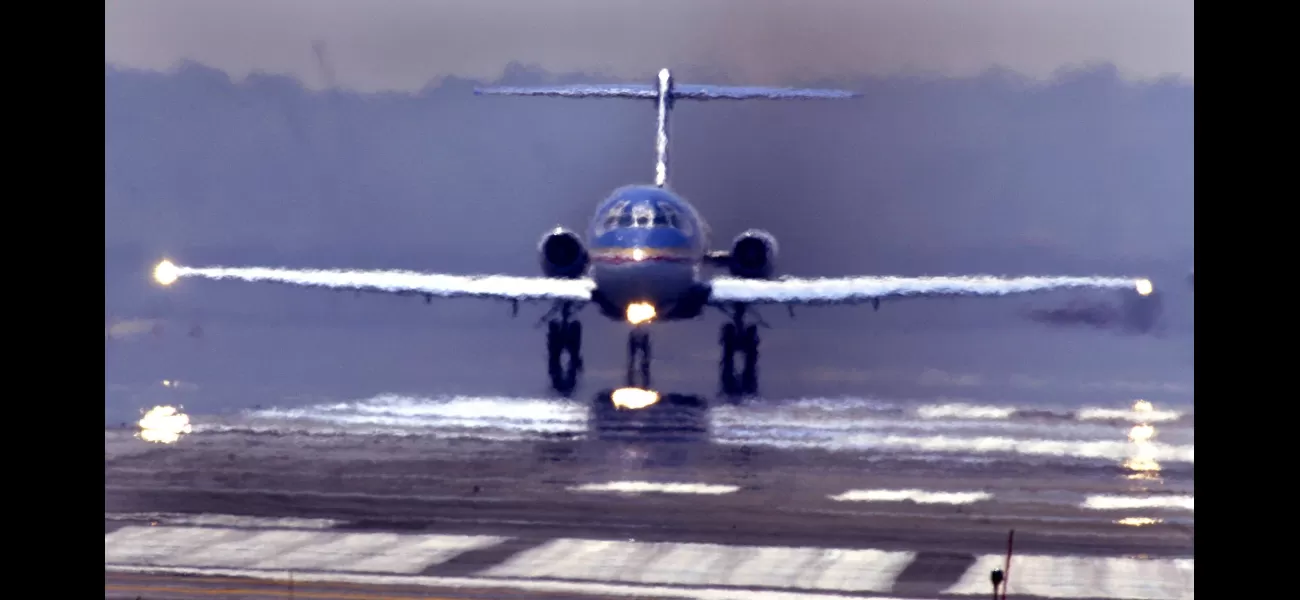Will heatwaves prevent planes from departing? Could this affect summer vacations?
Future flights will face increased disruption due to high temperatures.
July 24th 2024.

As temperatures continue to rise, airports in the UK are facing new challenges when it comes to getting planes off the ground. This is a cause for concern, especially considering that flying is already a major contributor to greenhouse gas emissions. With each passing year, heatwaves seem to be getting longer and hotter, making it increasingly difficult for airlines to operate.
Last year, millions of people flew out of UK airports, but the increasing frequency of searing weather systems has raised fears that airlines may be forced to leave passengers stranded on the ground. So, just how hot does it have to get for planes to be unable to take off? And what is the aviation industry doing to address this issue?
Denis Bilyarski, a manager of sustainable aviation at consultancy firm ICF, explains that heat is a concern for airlines because it reduces the lift generated by the wings of planes. This is particularly problematic for jets, which are already quite heavy. While this reduced lift is not a safety concern in and of itself, it can impact the number of passengers and overall load capacity of a plane, potentially leading to delays or cancellations.
New research from ten Greek airports has revealed that high temperatures and slow headwinds can significantly reduce a plane's maximum takeoff weight, sometimes by the weight of a passenger and their luggage. Paul Williams, a professor of atmospheric science at the University of Reading, studied these airports to understand how hot weather and other factors, such as short runways, affect planes.
According to Prof Williams and his team, extreme heat can make it difficult for planes to generate enough lift to take off. In some cases, it may even be impossible. This is because as the air warms, it expands, reducing the number of molecules available to push the plane up. With every 3°C increase in temperature, jets experience a 1% decrease in lift. Additionally, as global temperatures continue to rise, scientists have observed a decrease in beneficial headwinds, further impacting a plane's ability to take off.
So, what is the maximum temperature that planes can operate in? It is believed to be around 50°C, according to the US National Institute of Health. However, in 2017, when temperatures reached 48.8°C at Phoenix Sky Harbor Airport in the US, dozens of flights had to be cancelled. On the other hand, in cold weather, commercial planes can withstand temperatures as low as -55°C on the ground and up to -80°C in the air.
These take-off issues are most common at airports with high altitudes, where the air is already thin. When coupled with short runways, planes have limited space to accelerate and generate enough lift to take off. This has already affected major UK airports, such as London's City Airport during a heatwave in 2018.
While UK airports may not be the first to feel the effects of rising global temperatures, flights to holiday destinations at higher altitudes may become impossible in the future. Airports at high altitudes have naturally thin air and often have short runways, making it difficult for planes to generate enough lift. For example, a plane requires 6,500ft of runway at 20°C, but 8,200ft at 40°C. In comparison, Heathrow Airport, the busiest airport in the UK, sits at just 83ft, while airports like Daocheng Yading Airport in China and El Alto International Airport in Bolivia are located at much higher altitudes.
If you're flying across Europe in the winter, you're unlikely to experience any issues due to heat. However, in the peak of summer, your flight may be cancelled. This is what happened at London's City Airport in 2018, when extreme temperatures caused problems with the runways. With a runway of just under 5,000ft, City Airport is much shorter than Heathrow's, which is just under 13,000ft.
To avoid issues caused by extreme heat, sustainable aviation consultant Denis Bilyarski suggests scheduling flights during cooler times of the day, such as early morning or evening. However, this can be challenging during peak travel periods. Denis also notes that heat is a concern for ground staff and crew, as working in high temperatures without proper air conditioning can be uncomfortable and potentially unsafe.
The aviation industry has been researching the impact of climate change for years and working on solutions. As Denis mentioned, scheduling flights at cooler times of the day and using lighter aircraft are potential solutions. However, building longer runways at airports that are most affected by extreme heat is not a feasible solution. According to Professor Williams, there are many potential solutions, and Boeing already offers a "hot and high" option for some of its aircraft. But the good news is that it is rare for flights to be cancelled due to extreme heat, and this is not likely to change in the near future.
Denis warns that the industry needs to be careful with its immediate response to worsening heatwaves. It is crucial for the aviation industry to continue its efforts to decarbonize and reduce emissions, for example by increasing the production and use of sustainable aviation fuels, to avoid being outpaced by the impacts of climate change.
Last year, millions of people flew out of UK airports, but the increasing frequency of searing weather systems has raised fears that airlines may be forced to leave passengers stranded on the ground. So, just how hot does it have to get for planes to be unable to take off? And what is the aviation industry doing to address this issue?
Denis Bilyarski, a manager of sustainable aviation at consultancy firm ICF, explains that heat is a concern for airlines because it reduces the lift generated by the wings of planes. This is particularly problematic for jets, which are already quite heavy. While this reduced lift is not a safety concern in and of itself, it can impact the number of passengers and overall load capacity of a plane, potentially leading to delays or cancellations.
New research from ten Greek airports has revealed that high temperatures and slow headwinds can significantly reduce a plane's maximum takeoff weight, sometimes by the weight of a passenger and their luggage. Paul Williams, a professor of atmospheric science at the University of Reading, studied these airports to understand how hot weather and other factors, such as short runways, affect planes.
According to Prof Williams and his team, extreme heat can make it difficult for planes to generate enough lift to take off. In some cases, it may even be impossible. This is because as the air warms, it expands, reducing the number of molecules available to push the plane up. With every 3°C increase in temperature, jets experience a 1% decrease in lift. Additionally, as global temperatures continue to rise, scientists have observed a decrease in beneficial headwinds, further impacting a plane's ability to take off.
So, what is the maximum temperature that planes can operate in? It is believed to be around 50°C, according to the US National Institute of Health. However, in 2017, when temperatures reached 48.8°C at Phoenix Sky Harbor Airport in the US, dozens of flights had to be cancelled. On the other hand, in cold weather, commercial planes can withstand temperatures as low as -55°C on the ground and up to -80°C in the air.
These take-off issues are most common at airports with high altitudes, where the air is already thin. When coupled with short runways, planes have limited space to accelerate and generate enough lift to take off. This has already affected major UK airports, such as London's City Airport during a heatwave in 2018.
While UK airports may not be the first to feel the effects of rising global temperatures, flights to holiday destinations at higher altitudes may become impossible in the future. Airports at high altitudes have naturally thin air and often have short runways, making it difficult for planes to generate enough lift. For example, a plane requires 6,500ft of runway at 20°C, but 8,200ft at 40°C. In comparison, Heathrow Airport, the busiest airport in the UK, sits at just 83ft, while airports like Daocheng Yading Airport in China and El Alto International Airport in Bolivia are located at much higher altitudes.
If you're flying across Europe in the winter, you're unlikely to experience any issues due to heat. However, in the peak of summer, your flight may be cancelled. This is what happened at London's City Airport in 2018, when extreme temperatures caused problems with the runways. With a runway of just under 5,000ft, City Airport is much shorter than Heathrow's, which is just under 13,000ft.
To avoid issues caused by extreme heat, sustainable aviation consultant Denis Bilyarski suggests scheduling flights during cooler times of the day, such as early morning or evening. However, this can be challenging during peak travel periods. Denis also notes that heat is a concern for ground staff and crew, as working in high temperatures without proper air conditioning can be uncomfortable and potentially unsafe.
The aviation industry has been researching the impact of climate change for years and working on solutions. As Denis mentioned, scheduling flights at cooler times of the day and using lighter aircraft are potential solutions. However, building longer runways at airports that are most affected by extreme heat is not a feasible solution. According to Professor Williams, there are many potential solutions, and Boeing already offers a "hot and high" option for some of its aircraft. But the good news is that it is rare for flights to be cancelled due to extreme heat, and this is not likely to change in the near future.
Denis warns that the industry needs to be careful with its immediate response to worsening heatwaves. It is crucial for the aviation industry to continue its efforts to decarbonize and reduce emissions, for example by increasing the production and use of sustainable aviation fuels, to avoid being outpaced by the impacts of climate change.
[This article has been trending online recently and has been generated with AI. Your feed is customized.]
[Generative AI is experimental.]
0
0
Submit Comment





